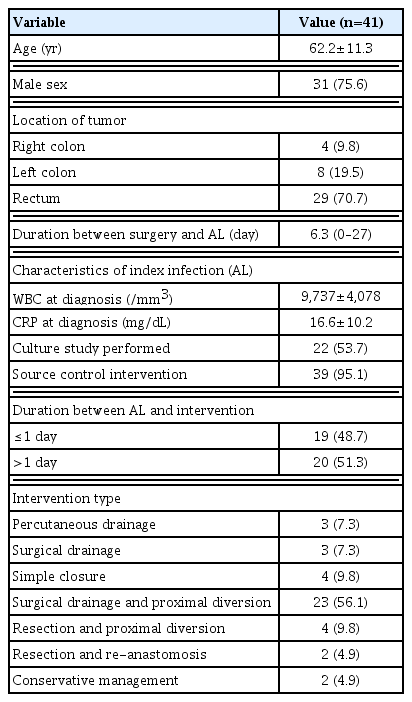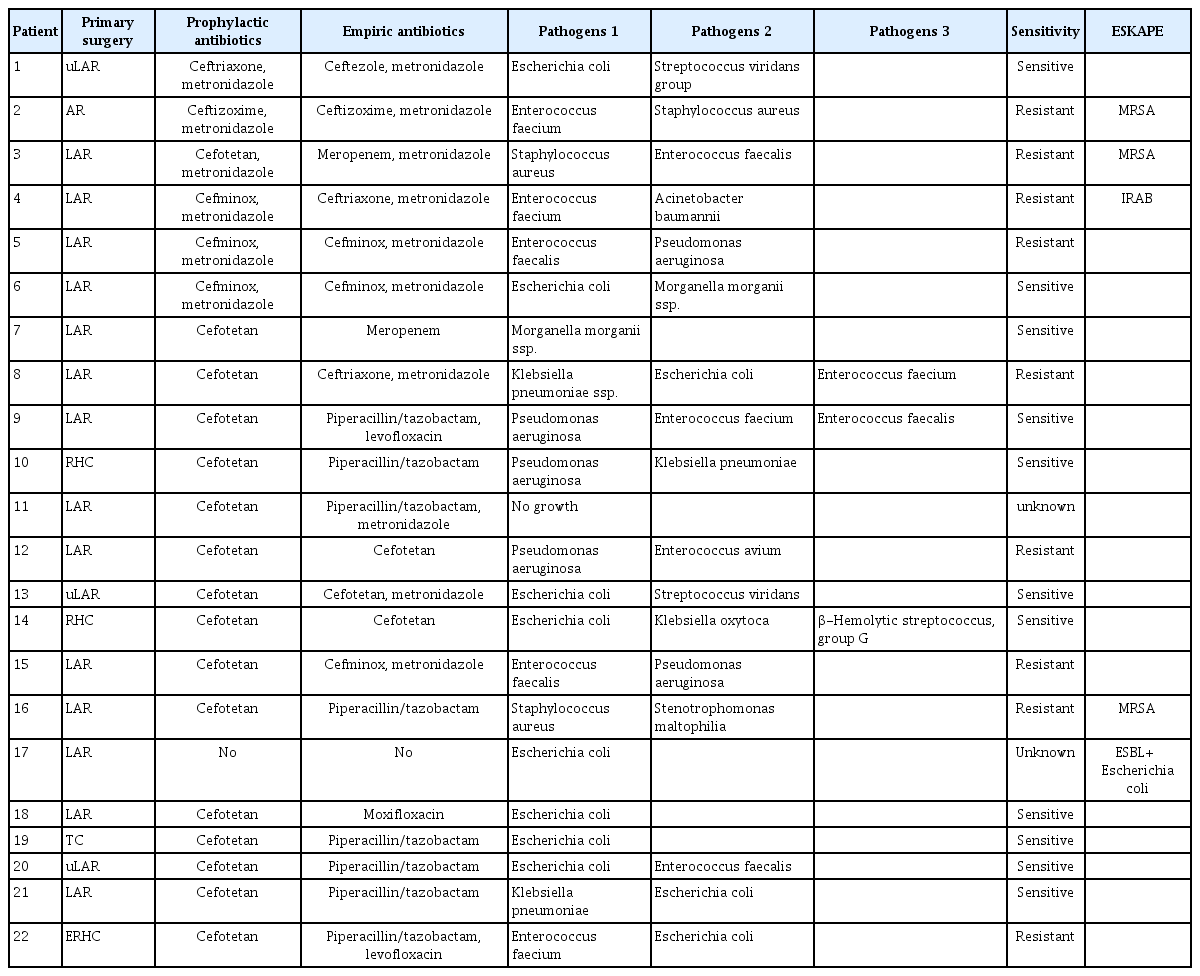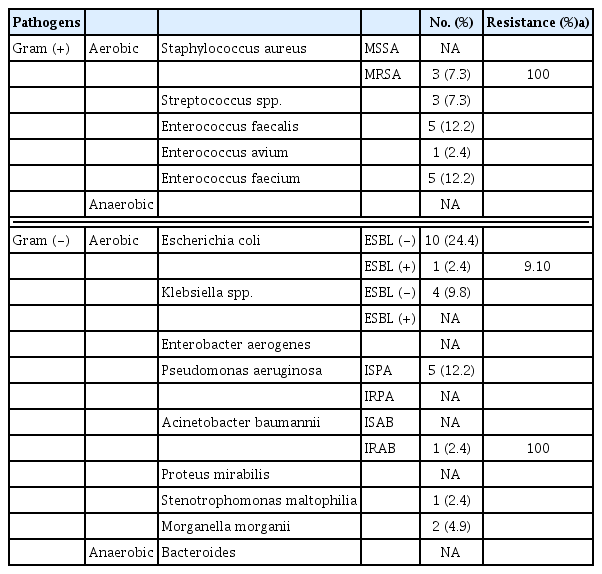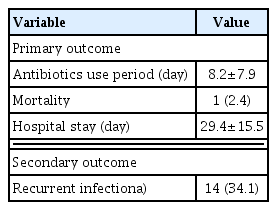Patterns of antibiotics and pathogens for anastomotic leakage after colorectal cancer surgery
Article information
Abstract
Purpose
Anastomotic leakage (AL) is a type of intra-abdominal infection (IAI) which requires appropriate antibiotics with proper intervention. This study aimed to improve the appropriateness of antibiotic treatment by assessing the patterns of antibiotic treatment and resistance of pathogen profiles in patients who had AL after colorectal cancer surgery.
Methods
From June 2006 through December 2017, the medical records of the patients who had AL after elective abdominal surgery for colorectal cancer in Kyung Hee University Hospital at Gangdong, Seoul, Korea were reviewed retrospectively. Baseline characteristics and consistence of antibiotics with culture study results were analyzed to evaluate the appropriateness of treatment.
Results
Among 982 patients who underwent primary surgery for colorectal cancer, 41 (4.2%) had AL. Mean time of diagnosis of AL from surgery was 6.3 days. The most commonly used prophylactic antibiotics for the primary surgery was 2nd generation cephalosporin (66.6%). Mean duration of prophylactic antibiotics usage was 2.8 days. The most commonly used empirical antibiotics after AL occurred was piperacillin and tazobactam (32.6%). Mean duration of empirical antibiotics usage was 8.2 days. The most commonly identified pathogens were Escherichia coli and Enterococci spp. (26.8% each), and 12.2% of the “ESKAPE” pathogens were identified. Resistance to empirical antibiotics was 45.5% (10/22).
Conclusion
Penetration of culture study for AL after colorectal cancer surgery appeared relatively low, although the profile of pathogens isolated from the AL patients can give important clues and evidence for appropriate antibiotics use. Surgeons should pay attention in performing culture studies for IAI including AL for proper patient treatment.
INTRODUCTION
Intra-abdominal infection (IAI) represents a wide variety of pathological conditions that can involve lesions of all the intra-abdominal organs. It should be treated with appropriate antibiotic therapy with proper interventions for source control. Choice of appropriate antibiotic must be based on the results of the culture study; the strain that caused the infection, profile of bacteria, and resistance to antibiotics. However, because the results usually require a few days, empirical antibiotics should be administered first, and then, the extension of the administration or the replacement of antibiotics can be considered depending on the results of the test [1].
Antibiotic resistance disables several mechanisms of antibiotics against bacteria, subsequently increases medical expense, as well as affects effectiveness of antibiotics against infection [2–4]. The Centers for Disease Control and Prevention has reported that the estimated minimum number of illnesses and deaths caused by antibiotics resistance were at least 2 million illness and 23,000 deaths each year in the United States [5]. In addition, guidelines already recommend appropriate antimicrobial agents on the basis of high-quality evidence and advise understanding of the microbiological profiles and resistance of the key pathogens causing IAI in each local region [6–9]. Even some authors made the acronym “ESKAPE” pathogens to emphasize the importance of appropriate antimicrobial therapy despite increasing antibiotic resistance [10].
Anastomotic leakage (AL) after colorectal cancer surgery remains the most feared and disastrous complication for both surgeon and patient, affecting long-term oncologic outcomes as well as frequent need for redo interventions, longer hospitalization, and high mortality rates [11]. AL is also a type of IAI in which the infection source leaks through the intestinal anastomosis for which proper antibiotics is mandatory with proper intervention. In most case of suspected AL, empirical antibiotics are administered targeting the gut flora. However, only a few studies assessed the relevance of antibiotics for AL. This study aimed to improve the appropriateness of antibiotic treatment by assessing the patterns of antibiotic treatment and resistance of pathogen profiles in patients who had AL after colorectal cancer surgery.
METHODS
From June 2006 through December 2017, consecutive patients who underwent elective abdominal surgery for colorectal cancer in our hospital were screened. The medical records of the patients were reviewed retrospectively after approval by the Institutional Review Board (IRB) of Kyung Hee University Hospital at Gangdong (IRB No. KHNMC 2018-08-017). Among the all screened patients, cases of surgery for recurrence or reoperation were excluded. Data of the patients who had AL after primary surgery were reviewed retrospectively.
Eligible patients’ sex, age, height, weight, location of tumor, type of surgery, type and duration of prophylactic antibiotics before surgery, date of AL diagnosed from the day of surgery, white blood cell count (WBC), C-reactive protein (CRP), type of procedure or operation for AL, and time from AL to procedure or surgery were recorded. In addition, results of culture study from the abdominal fluid or abscess after AL was diagnosed, antibiotic resistance, the type and duration of empirical or therapeutic antibiotics administered for the purpose of treatment for AL, hospital stay, and mortality were analyzed.
Location of tumor varied as right colon, left colon, and rectum, and transverse colon cancer was regarded as right side near the proximal part or left side near the distal part. As for data on WBC and CRP, the most recent data from the diagnosis of AL were recorded. Types of source control procedure were classified as follows; percutaneous drainage, surgical drainage, simple closure, surgical drainage and proximal diversion, resection and proximal diversion, resection, and re-anastomosis.
To evaluate the appropriateness of treatment, consistence of antibiotics with culture study results and recurrent infection including surgical site infection (SSI) occurring within 30 days after intervention were analyzed.
RESULTS
During the study period, a total of 982 patients underwent elective surgery for the treatment of primary colorectal cancer. Among them, 41 patients (4.2%) experienced AL (Table 1), and culture studies for intra-abdominal fluid or abscess from AL were performed in 22 patients (53.7%). The most frequent diagnosed site of AL was rectum (n=29, 70.7%), and 39 of 41 patients underwent intervention for source control whereas two patients were treated with only antibiotics. Source control interventions were performed within 1 day from AL in 19 patients (46.3%).
Surgical drainage and proximal diversion was performed most for source control of AL (n=23, 56.1%), followed by simple closure (n=4), resection and proximal diversion (n=4), percutaneous drainage (n=3), surgical drainage (n=3), and resection and re-anastomosis (n=2).
Antibiotic use and the results of culture study for pathogens from intra-abdominal samples are listed in Table 2. Except for one patient in which no bacteria grew, 11 kinds, 41 (duplicate) pathogens were identified in 21 patients, and approximately two kinds of bacteria were found per patient. Escherichia coli and Enterococcus spp. (26.8% each) were the most frequently identified, followed by Pseudomonas aeruginosa (12.2%). Twelve point one percent of the “ESKAPE” pathogens were identified including methicillin-resistant Staphylococcus aureus (MRSA) (7.3%), extended-spectrum beta-lactamase (ESBL)-producing E. coli (2.4%), imipenem-resistant Acinetobacter baumannii (IRAB) (2.4%) [12].
Pathogens identified were described in Table 3. Resistant rates of each pathogen show a wide spectrum from 9.1% to 100%. Resistant rates of MRSA (3/3), IRAB (1/1) were reported as 100%. Resistant rates of ESBL-producing E. coli isolates comprised 9.1% (1/11) of all E. coli isolates.
Prophylactic antibiotics administration was confined to the cephalosporins for 39 of 41 patients and combined with metronidazole in 11 patients (26.2%) (Table 4). Two patients were not administered prophylactic antibiotics because they were already being treated with therapeutic antibiotics that focused on underlying infectious disease. The mean duration of administration was 2.8 days, but the duration of prophylactic antibiotic treatment for the last 5 years was 1.1 days. This is in accordance with the trend of recent guideline for prophylactic antibiotic in surgery, which recommended that the postoperative duration of antimicrobial prophylaxis can be reduced [13,14].
The prescribed therapeutic empiric antibiotics patterns are listed in Table 5. Of the 43 antibiotics including overlapping, 14 (32.6%) piperacillin/tazobactam were administered and eight 2nd generation cephalosporin only (18.6%), and five 2nd and 3rd generation cephalosporin plus metronidazole, fluoroquinolone (11.6% each) were administered. Carbapenem was given only for one patient (2.3%). Glycopeptides (Vancomycin) and Glycyclines (Tigecyclin) were never used as empirical antibiotics. On the other hand, no antibiotics were prescribed to four patients (9.3%) because the symptoms of AL were relatively mild for those patients.
Mean duration of empirical antibiotics use were 8.2 days (Table 6), which is similar with the recommendations of recent guidelines [15]. In-hospital mortality rate was 2.4% and cause of death was sepsis. Mean hospital stay was 29.4 days (range, 10–68 days). Fourteen patients (34.1%) had recurrent infection including SSI after source control. In 10 of 22 patients (45.5%) who had culture study, identified pathogens were reported to be resistant to the given empirical antibiotics (Table 2).
DISCUSSION
Secondary peritonitis is a consequence of a mechanical breach of the gastrointestinal tract. The microbial species isolated reflect the patterns of colonization of the involved level of the gastrointestinal tract: perforation of the stomach or duodenum results in an inflammatory process that is primarily chemical, whereas perforations of the colon create polymicrobial infections including AL after colorectal cancer surgery [16]. It explains the importance of knowledge on organ origin of infection because it helps clinicians choose the appropriate treatment, including selection of antibiotics.
The authors assessed the pathogens from the infected source from AL after colorectal cancer surgery and found a relatively low proportion of culture study performance (22/41, 53.7%) and appropriate antibiotics according to antibiotic resistance (12/22, 54.5%).
Although only 4.2% of AL was reported after overall colorectal cancer surgery, it scarcely occurred in right colon cancer surgery. When limited to left colon or rectal cancer surgery, 37 of 389 patients (9.5%) had AL after primary surgery.
We reviewed empirical antibiotics prescription pattern and infection severity with these patients. Only 22 patients (53.7%) had culture study from the intraperitoneal source (abscess or fluid) and the pathogens were identified from 21 patients. This low performance of culture study might be due to lack of interest by surgeons, rather than lack of time. Moreover, although most of the pathogens are expected to be gut flora (possibly one of the reasons culture studies were not performed), the authors found that proper antibiotics use rates were only 54.5% considering antibiotic resistance (Table 2).
The pathogen distribution identified in this study was slightly different from previous reports. Data from the Study for Monitoring Antimicrobial Resistance Trends (SMART) provide the best available evidence for the current status of complicated IAIs in Asia [17,18]. Over the course of the SMART, the five most commonly isolated Gram-negative pathogens from IAIs were E. coli (47.8%), Klebsiella pneumoniae (14.5%), P. aeruginosa (9.4%), Enterobacter cloacae (6.0%), and Proteus mirabilis (3.6%) [19]. The CIAOW (Complicated intra-abdominal infections worldwide observational study) collected the data from 1898 patients in 68 medical institutions worldwide [19]. From the study, the top pathogens from IAIs were E. coli (35.7%), Enterococcus (12.9%), Klebsiella (10.5%), P. aeruginosa (5.1%), Enterobacter spp. (4.1%). In our study, Gram-positive microbe was 41.5% of all pathogens identified. Enterococci was found to be 26.8% the same as E. coli, and S. aureus was as much as 7.3%. Regarding resistance, it is remarkable that MRSA was identified in 100% of all S. aureus (4/4).
Rice [10], in 2008, coined the acronym of “ESKAPE” pathogens including Enterococcus faecium, S. aureus, K. pneumoniae, A. baumannii, P. aeruginosa, and Enterobacter species to emphasize that these bacteria currently cause the majority of hospital infections and effectively “escape” the effects of antibacterial drugs [20]. Published surveillance studies have consistently reported that Gram-negative bacilli, including ESKAPE pathogens, isolated from patients in several countries within the Asia-Pacific region, generally demonstrate higher rates of antimicrobial resistance than observed in North American and European studies, and that the majority of pathogens isolated from intensive care units in a number of Asia-Pacific countries are members of the ESKAPE group [21,22].
AL belongs to the category of hospital acquired (HA)-IAI and the pathogen spectrum is different from those of community acquired-IAI. For this reason, treatment of AL patients should be administration of broad antibiotics, as in the treatment of HA-IAI patients, with an understanding of pathogen patterns in the region, and the selection of antibiotics to cover the resistant strains accordingly. Especially, it is recommended to consider prescribing agents covering MRSA when clinicians treat the secondary peritonitis caused by colon and rectum in this region due to higher rates of MRSA identification than other guidelines.
Regarding behavior of antibiotics prescription in accordance with published guidelines, it could be considered that 54.5% of 41 patients were prescribed appropriately with narrow-spectrum antibiotics. Broad-spectrum antibiotics such as piperacillin/tazobactam or carbapenem should have been prescribed for HA-IAI such as AL patients, and narrow-spectrum antibiotics, which can resist ESKAPE strains, should have been avoided [6,8,9].
There are several limitations in this study. Selection bias from the retrospective nature is inevitable. Moreover, culture study of pathogens, which is the most important procedure in this study, was performed only in about half of the patients with AL. Lastly, consistency of prophylactic and empirical antibiotic use lack regarding both kind and duration of antibiotics.
In conclusion, penetration of culture study for AL after colorectal cancer surgery appears relatively low, although the profile of pathogens isolated from AL patients can give important clues and evidence for appropriate antibiotics use. Surgeons should pay attention in performing culture studies for IAI including AL to treat patients with the proper method without wasting time and cost. Further studies are required to update the current status and problems of antibiotics use.
ACKNOWLEDGMENTS
This work was supported by a National Research Foundation of Korea (NRF) grant funded by the Korean Government Ministry of Education (No. 017R1D1A1B03030948).
Notes
This work was presented as an oral presentation at the 51st Annual meeting of the Korean Society of Coloproctology, on March 30 to April 1, 2018, in Gwangju, Korea.
CONFLICT OF INTEREST
No potential conflict of interest relevant to this article was reported.






